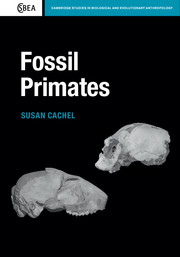Book contents
- Frontmatter
- Dedication
- Contents
- Acknowledgments
- Preface
- 1 Introduction: primates in evolutionary time
- 2 Primate taxonomy
- 3 Fossils and fossilization
- 4 The world of the past
- 5 The lifeways of extinct animals
- 6 Evolutionary processes and the pattern of primate evolution
- 7 Primate origins
- 8 The Paleocene primate radiation
- 9 The Eocene primate radiation
- 10 The Malagasy primate radiation
- 11 The Oligocene bottleneck
- 12 Rise of the anthropoids
- 13 The platyrrhine radiation
- 14 The Miocene hominoid radiation
- 15 The cercopithecoid radiation
- 16 Late Cenozoic climate changes
- 17 Conclusions
- References
- Index
5 - The lifeways of extinct animals
Published online by Cambridge University Press: 05 April 2015
- Frontmatter
- Dedication
- Contents
- Acknowledgments
- Preface
- 1 Introduction: primates in evolutionary time
- 2 Primate taxonomy
- 3 Fossils and fossilization
- 4 The world of the past
- 5 The lifeways of extinct animals
- 6 Evolutionary processes and the pattern of primate evolution
- 7 Primate origins
- 8 The Paleocene primate radiation
- 9 The Eocene primate radiation
- 10 The Malagasy primate radiation
- 11 The Oligocene bottleneck
- 12 Rise of the anthropoids
- 13 The platyrrhine radiation
- 14 The Miocene hominoid radiation
- 15 The cercopithecoid radiation
- 16 Late Cenozoic climate changes
- 17 Conclusions
- References
- Index
Summary
Introduction
Georges (Baron) Cuvier (1769–1832), who worked in the late eighteenth century, is often identified as the Father of Vertebrate Paleontology. He achieved this eminence by virtue of two things. First, he recognized that some organisms had become extinct. The idea that species were not immortal was a revolutionary one. Species were traditionally held to have remained unchanged and immutable since the point of Creation. Cuvier believed that episodic global catastrophes accounted for these extinctions. A new creation would account for subsequent species. The history of life on earth thus became a series of revolutionary extinctions and creations.
Second, Cuvier recognized that fossil bones and teeth resembled those of living animals, and that these bones and teeth could be used to reconstruct the lifeways of extinct creatures. In fact, it was the fond expectation of Baron Cuvier that future anatomists would discover morphological rules or relationships that would allow an absolute knowledge of the lifeways of an extinct species from even a single bone or tooth. Animals were machines whose bodies worked through mechanical principles. It was the duty of functional morphologists to discover these principles. Cuvier seems to have expected that there would be an inevitable relationship between an animal’s niche and its anatomy. In the same way that mathematicians have discovered the equations for an ellipse or a circle, Cuvier believed that future anatomists would discover the absolute relationships, as rigorous as equations, between form and function. To this end, Cuvier articulated a “law” of correlation of parts.
In a word, the shape of the tooth implies the shape of the condyle, that of the scapula, that of the nails, just as the equation of a curve implies all its properties; and just as by taking a property separately as the basis of a particular equation, one would find again and again both the ordinary equation and all the other properties, similarly the nails, the scapula, the condyle, the femur and all the other bones taken separately, give the tooth, or give each other; by beginning with any of them, someone with a rational knowledge of the laws of organic economy could reconstruct the whole animal.
(Fortelius 1990:210).- Type
- Chapter
- Information
- Fossil Primates , pp. 66 - 89Publisher: Cambridge University PressPrint publication year: 2015



